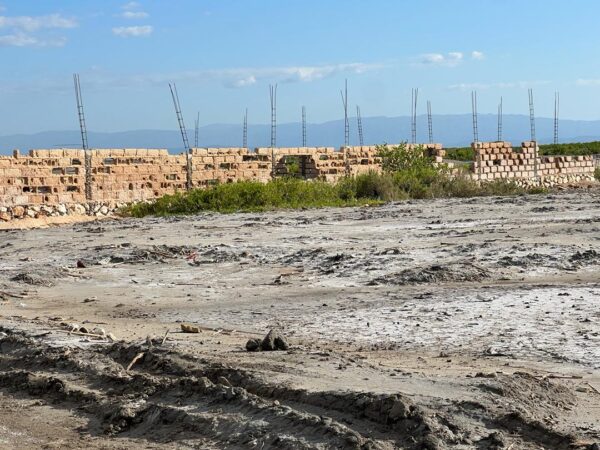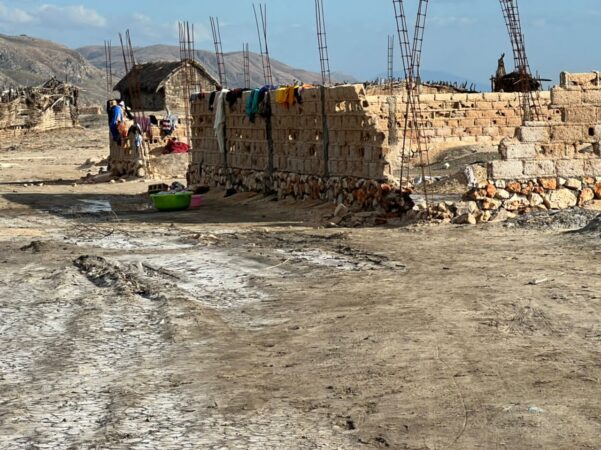Anarchic constructions on the salt mine of Trou-Couleuvre pose « a real danger that can have dire consequences for the future of salt production in Gonaïves, » warns an owner of four salt pans
Anarchic construction on the Trou-Couleuvre salt mine is threatening the future of one of Gonaïves’ two largest salt production pockets. This is what local residents and entrepreneurs have told AyiboPost.

Anarchic constructions were observed around a pond in Trou-Couleuvre in February 2024.
Gonaïves is one of Haiti’s leading salt-producing localities. The high salinity of the seawater makes the region one of the best places for sea salt production.
Though these haphazard constructions can be a relief for the less fortunate, they are a source of discontent for the owners of the salt ponds.

Around a pond in Trou-Couleuvre, anarchic constructions were found in February 2024.
Widelande Dort, a woman in her late thirties, has resided on the Trou-Couleuvre mine site since September 2019. A mother of four, she left Bigot, an area located at the entrance to the town, to settle in this space following the advice of a gossip who praised the affordable price of land.
Although she was able to settle in cheaply, the saltpeter climbing up the walls of her dilapidated tin shack gradually damaged the structure, to the point where she was forced to make several repairs at short intervals.
“I am at an economic impasse, because the maintenance of the house eats into my meager income from time to time,” laments the widowed mother.

View of a « small house » whose walls are deteriorating gradually.
The locality of Trou-Couleuvre is located on the outskirts of the city of Gonaïves and represents one of the largest non-iodized salt production basins in the Artibonite department.
Read also: Artibonite : l’État abandonne ces « Sources chaudes » aux vertus thérapeutiques
The locality is home to over 50 salt ponds around which commercial relationships are established between the owners and small daily salt vendors on the local market.
Defrance lives there. For him, the high cost of renting a suitable house in the heart of the city, which can vary from 25,000 to 75,000 gourdes depending on the location, motivated his decision to live on the salt mine site with his three children.
“It’s our last resort,” says the man who sells lottery tickets to ensure his children’s livelihood.
At Trou-Couleuvre, on the edge of the salt ponds, the homes stand out against a backdrop of poverty, decrepit and ravaged by saltpeter.
On both sides, these shacks made of cardboard and corrugated iron covered with rust exhibit their anachronism, while those built from disemboweled blocks don’t give the impression that they’ll withstand the first tremors of a cyclone or a gust of wind.

Children play not far from the anarchic constructions in Trou-Couleuvre.
Légitime Julien has lived in the area for 7 years. Father to 7 children, the man admits that he has deficits in terms of repairs compared to the state of his home.
“The salt takes around 4 to 6 months, at most a year, to start eating away at buildings,” he relates.
This shanty town-like belt which tightens around the salt mine worries the salt pond owners.
Antoine Cénoble, 57, is stepping up to the plate.
“It’s a real danger which could have unfortunate consequences for the future of salt production in Gonaïves,” reasons the man who owns four salt ponds.
Not only do these structures have a negative impact on salt production, but they are also real dangers, as “the effect of saltpeter weakens them and they are not insured in the long term,” laments the concerned man.

View of the effect of saltpetre on the blocks constituting the walls.
Salt ponds are generally excavations of several feet in salt marshes, lined with embankments. Inside these ponds, water is added as well as leaves from the Rock Samphire tree (crithmum maritimum) to encourage the crystallization of the salt.
Individual salt consumption in Haiti, estimated at around 35 grams per day in 2012, is far from the WHO recommendation of 4 grams per day. In other words, salt consumption in Haiti is approximately 8.75 times higher than the WHO recommendation, raising major public health concerns.
Read also : Le gros sel cultivé en Haïti contient un excès de magnésium. Ceci rend son iodation difficile.
Areas like Grande Saline, Gonaïves, Aquin, Fort-Liberté and Anse-Rouge are important production pockets.
For Pastor Gordon Chéry, 67, owner of 3 salt ponds, the anarchic construction in Trou-Couleuvre began in 2015 and increased in the last 5 years.
Despite protests from salt pond owners, some people even go so far as to build their houses near the bottom of the ponds.
These spaces, along the sea, are not spared from natural hazards.
“The damage is considerable in the area when the Quinte, during flood periods, descends and vigorously beats the Saline area,” relates Chéry.
At 40 km long and with a basin of 700 km2, the river causes considerable damage during periods of high water. One example dates back to 2004, when Hurricane Jeanne caused the death of over 3,000 people in the country’s fourth-largest city.

The degrading state of the coastline in Trou-Couleuvre.
Raining bullets, drawing knives and machetes… conflicts between salt marsh owners and newcomers sometimes get out of hand, according to Pastor Gordon Chéry.
These constructions may also be illegal.
The January 2013 edition of the Haitian National Building Code (CNBH), in section 1.2, requires a permit from the municipality for the construction of a building, as well as information indicating that the land is not located in a risk or protected zone, among other things.
However, in Trou-Couleuvre, it seems that people ignore these formalities.
Read also : Photos | Des Haïtiens repoussent la mer à Carrefour pour «fè tè». Une pratique dangereuse.
Pond owner Antoine Cénoble tells AyiboPost that in the locality, the granting of plots of land is done in total disorder, under the absent gaze of the town’s authorities.
“People unduly appropriate land, and sometimes it is individuals without any title who sell it on the sly for derisory sums,” he laments.
Cénoble still remembers this episode from March 2023, where he chased away a man who was planting stakes on land he had bought to make a salt pond, preventing him from selling it without his knowledge.

View of the effect of saltpeter on the blocks constituting the walls.
Donald Diogène, the interim mayor of the city, acknowledged the anarchic and illegal nature of these constructions in the salt marshes area to AyiboPost on February 22, 2023.
While maintaining that efforts are being made to respond to this problem with the help of civil protection, the mayor revealed the impotence of the municipality.
“We do not have the necessary room to undertake major actions, because the town hall is cruelly suffering from a lack of financial resources. We can’t even pay our back wages,” he regrets.
But above all, many people in the city suffer from a housing problem.
By Wilno Casimir & Junior Legrand
The photos are by Wilno Casimir.
Cover image : A man working in a salt mine.
Keep in touch with AyiboPost via:
► Our channel Telegram : Click here
► Our Channel WhatsApp : Click here
► Our Community WhatsApp : Click here







Comments